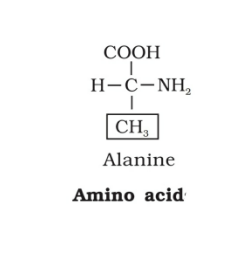
Draw the structure of amino acid Alanine.
Answer
465.6k+ views
Hint: Alanine is α-amino acid which is used in biosynthesis of proteins through a process called translation, in which all the amino acids along with alanine polymerise form a polypeptide chain by polypeptide bond between them.
Complete step by step answer:

1.Amino acids are the constituent of protein. Although about 300 amino acids occur in nature, only 20 of them enter into the composition of proteins. Each amino acid contains a centrally located carbon atom called α-carbon to which four groups are attached: a basic amino group (-NH+ 3 an acidic carboxyl group (-COOh- , a hydrogen atom and a group of varying chemical structures called a side chain (R-group).
2.With four different groups attached to it, the a-carbon is said to be asymmetric. There are various ways to classify the amino acids :
(i) Common amino acids found in proteins
(ii) Uncommon amino acids
(iii) Amino acids not found in proteins.
3. Common amino acids found in proteins are grouped into:
(i) Nonpolar (hydrophobic) amino acids
(ii) Polar amino acids (neutral amino acids)
(iii) Acidic amino acids and
(iv) Basic amino acids
4.Alanine is one of the non-polar aliphatic amino acid.
In alanine the side-chain is a methyl group (-CH3) which is connected to α-carbon. It is the simplest α-amino acid after glycine.
The methyl group attached at the side-chain of alanine is non-reactive and is therefore hardly ever directly involved in protein function. Alanine is a nonessential amino acid, meaning it can be produced by the human body, and does not need to be obtained through the diet. Alanine can be found in a wide variety of foods, but is particularly found in meats.
Note: Some functions of Amino acids are:
Histidine is a precursor to histamines, which work to protect the body from different allergic reactions. It is also important for building haemoglobin and helping to prevent anaemia from occurring.
Leucine assists with muscle recovery and increases mass from exercise. It also helps in the regulation of blood sugar, along with supplying energy to the body.
Isoleucine functions like Leucine for muscle recovery and blood sugar regulation. Additionally, this is needed for haemoglobin to be formed.
Valine combines with Leucine and Isoleucine to make an amino acid group called BCAAs, or branched chain amino acids. It is also needed for muscle metabolism and tissue repair. It is also supposed to help if there are liver or gallbladder problems.
Complete step by step answer:

1.Amino acids are the constituent of protein. Although about 300 amino acids occur in nature, only 20 of them enter into the composition of proteins. Each amino acid contains a centrally located carbon atom called α-carbon to which four groups are attached: a basic amino group (-NH+ 3 an acidic carboxyl group (-COOh- , a hydrogen atom and a group of varying chemical structures called a side chain (R-group).
2.With four different groups attached to it, the a-carbon is said to be asymmetric. There are various ways to classify the amino acids :
(i) Common amino acids found in proteins
(ii) Uncommon amino acids
(iii) Amino acids not found in proteins.
3. Common amino acids found in proteins are grouped into:
(i) Nonpolar (hydrophobic) amino acids
(ii) Polar amino acids (neutral amino acids)
(iii) Acidic amino acids and
(iv) Basic amino acids
4.Alanine is one of the non-polar aliphatic amino acid.
In alanine the side-chain is a methyl group (-CH3) which is connected to α-carbon. It is the simplest α-amino acid after glycine.
The methyl group attached at the side-chain of alanine is non-reactive and is therefore hardly ever directly involved in protein function. Alanine is a nonessential amino acid, meaning it can be produced by the human body, and does not need to be obtained through the diet. Alanine can be found in a wide variety of foods, but is particularly found in meats.
Note: Some functions of Amino acids are:
Histidine is a precursor to histamines, which work to protect the body from different allergic reactions. It is also important for building haemoglobin and helping to prevent anaemia from occurring.
Leucine assists with muscle recovery and increases mass from exercise. It also helps in the regulation of blood sugar, along with supplying energy to the body.
Isoleucine functions like Leucine for muscle recovery and blood sugar regulation. Additionally, this is needed for haemoglobin to be formed.
Valine combines with Leucine and Isoleucine to make an amino acid group called BCAAs, or branched chain amino acids. It is also needed for muscle metabolism and tissue repair. It is also supposed to help if there are liver or gallbladder problems.
Recently Updated Pages
Can anyone list 10 advantages and disadvantages of friction

What are the Components of Financial System?

How do you arrange NH4 + BF3 H2O C2H2 in increasing class 11 chemistry CBSE

Is H mCT and q mCT the same thing If so which is more class 11 chemistry CBSE

What are the possible quantum number for the last outermost class 11 chemistry CBSE

Is C2 paramagnetic or diamagnetic class 11 chemistry CBSE

Trending doubts
10 examples of friction in our daily life

The correct order of melting point of 14th group elements class 11 chemistry CBSE

Difference Between Prokaryotic Cells and Eukaryotic Cells

One Metric ton is equal to kg A 10000 B 1000 C 100 class 11 physics CBSE

What is the specific heat capacity of ice water and class 11 physics CBSE

State and prove Bernoullis theorem class 11 physics CBSE




